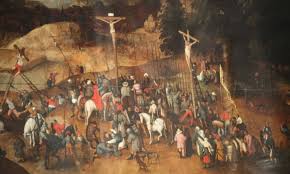Italian stamps showcase stolen artworks

Rome: Italy has issued a set of stamps depicting stolen artworks recovered by its “monuments men” taskforce.
The stamps, which show works by Van Gogh, Mantegna and Raphael, celebrate the 50th anniversary of the Command for the Protection of Cultural Heritage. The carabinieri – Italian police – taskforce’s nickname comes from the George Clooney film based on the allied group of investigators that was tasked with securing artworks looted by the Nazis at the end of the second world war.
The stamps are held in a folio with a background bearing the Nativity with St Francis and St Lawrence, painted by Michelangelo Merisi, better known as Caravaggio. That work is considered the Holy Grail of stolen art, and is among the FBI’s 10 most sought-after works. It has not been seen since disappearing from the L’Oratorio di San Lorenzo church in Palermo in 1969.
Despite the carabinieri’s record of success – more than 3m objects of art and archaeology have been found – the new stamps highlight the fact that more than a million Italian artworks remain unrecovered.
“It is no coincidence that half of the thefts in 2018 were carried out in places of worship,” said Lt Col Massimiliano Quagliarella from the carabinieri taskforce. “Many Italian churches are bona fide museums. These are accessible places of worship, and as such they are not always equipped with proper security measures.”
The stolen items are sold illegally, passed through different owners and often end up in the homes of the wealthy or in museums. It is not unusual for 30 years to pass before a stolen item reaches an owner, who is often unaware that the piece had been stolen in the first place.
According to investigators, the illicit trafficking of art in Italy amounts to billions of euros. Caravaggio’s Nativity has an estimated value of €30m (£26m). But according to Prof Maria Concetta di Natale, an art historian and professor of museology at the University of Palermo, it is “priceless”. “It is one of Caravaggio’s most exquisite works, which represents all of us, our history. And history cannot be bought,” she said.
The Nativity disappeared on the night of 18 October 1969, six months after the creation of the carabinieri taskforce. Since then, its fate has captured the imagination of art enthusiasts, with some even speculating the painting may have been eaten by rats, and others that Totò Riina, the late boss of the Sicilian Cosa Nostra, used it as a bedside rug.
Last June, hopes of solving one of the most infamous crimes in art history were reignited when investigators said they believed the Nativity could have been hidden in Switzerland. The new lead on the painting – a depiction of the newborn Christ on a bed of straw – came from a former mobster who said it had once been in the possession of Gaetano Badalamenti, a Sicilian “boss of bosses” who was known as one of the ringleaders of heroin trafficking.
Another stolen masterpiece is also believed to be in Switzerland: Antonello da Messina’s Ecce Homoe, which disappeared from a museum in Novara in 1974. A security system had not been installed because it was considered too costly.
In some cases stolen paintings end up damaged or worse. Some investigators believe Gustav Klimt’s Portrait of a Woman, which was stolen in Piacenza in 1997 after being discovered just a year earlier, has been destroyed. DNA traces on the frame led investigators to believe that the painting had fallen into the hands of a satanic sect, which had used it for a ritual in a cemetery and sealed it in the coffin of a dead girl.
However, Italy’s monuments men have sharpened their weapons in the fight against stolen art, and have even begun to gain the upper hand. Last March, thieves broke into the display case in the Santa Maria Maddalena church in the town of Castelnuovo Magra and made off with The Crucifixion, a €3m painting by the Flemish artist Pieter Brueghel the Younger. The heist appeared to have gone entirely according to plan. However, hours later, police revealed there had been one hitch: the snatched artwork was a copy. The original had been safely stored away the previous month as part of a carefully concocted bluff.





